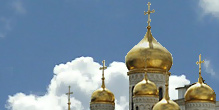 |
 |

|
 |
 |
QUESTION:
I attended an Orthodox funeral Today. I noticed that the deceased person had a piece of paper on his forehead with lettering on it. The deceased person also had some type of prayer written on it. After the priest blessed and annointed the body, he folded up the paper prayer and put it in the deceased's left hand. What do these two customs mean during a funeral ceremony?
ANSWER:
The paper band on the forehead signifies a crown of glory or victory; just as a runner in the ancient Olympics received a crown of victory for completing the race successfully, so too the departed are crowned in victory for completing life's ourse. The lettering is usually the prayer, "Holy God, Holy Mighty, Holy Immortal, have mercy on us."
The prayer written on the piece of paper you observed in the casket is knownas the "Prayer of Absolution." The priest reads this prayer at theend of the funeral service, during which he proclaims that the sins of the departedare forgiven.
These two customs are not universal among all Orthodox Christians, however. In some places, depending on the origins of the parish, they are observed; in others they are not. In every instance, however, the Prayer of Absolution is read, either from the separate sheet sometimes placed in the coffin or from the service book.
Published in January 2011.
Read more Christian articles
Recommend this page to your friend!
|
 |
 |

| Read also: |
|
|

|
|

